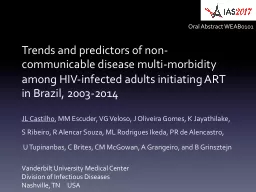

JL Castilho MM Escuder VG Veloso J Oliveira Gomes K Jayathilake S Ribeiro R Alencar Souza ML Rodrigues Ikeda PR de Alencastro U Tupinanbas C Brites ID: 633543
Download Presentation The PPT/PDF document "Trends and predictors of non-communicabl..." is the property of its rightful owner. Permission is granted to download and print the materials on this web site for personal, non-commercial use only, and to display it on your personal computer provided you do not modify the materials and that you retain all copyright notices contained in the materials. By downloading content from our website, you accept the terms of this agreement.
Slide1
Trends and predictors of non-communicable disease multi-morbidity among HIV-infected adults initiating ART in Brazil, 2003-2014
JL Castilho, MM Escuder, VG Veloso, J Oliveira Gomes, K Jayathilake, S Ribeiro, R Alencar Souza, ML Rodrigues Ikeda, PR de Alencastro, U Tupinanbas, C Brites, CM McGowan, A Grangeiro, and B Grinsztejn
Oral Abstract WEAB0101
Vanderbilt University Medical Center
Division of Infectious Diseases
Nashville, TN USASlide2
Conflict of Interest
None to declareSlide3
Background
Multi-morbidity from non-communicable diseases is common among aging HIV+ adults on ARTAssociated with functional decline, loss of quality of life, and mortalityCoorte Brasil: multi-site observational cohort to examine clinical outcomes of HIV+ adults on ART in BrazilSlide4
Methodology
With CCASAnet, non-communicable disease (NCD) outcomes collected and validated from medical records (2003-2014)Outcome: incident multi-morbidity (2 or more cumulative NCDs) after ART initiationStatistical Approach:Poisson regression Cox proportional hazard models
Salvador
Belo
Horizonte
Rio de Janeiro
Rio
Preto
São Paulo
(2 clinics
)
Porto
Alegre
BrazilSlide5
Cohort
Incident NCD eventsNHigh-grade hyperlipidemia437Diabetes
197Osteoporosis
107Coronary artery disease
49
Non-AIDS cancers
49
Venous thromboembolism
40
Chronic kidney disease
36
Cirrhosis
33
Cerebrovascular disease
28
Osteonecrosis
9
N=5,503
(
20,976 person-years)
1,796 women (33%)
Baseline age: 36.6 years
Baseline CD4: 226 cells/mm
3
ART regimen: 69% NNRTI
270 (5%) had 1 non-communicable disease (NCD) at baseline
Median follow-up: 3.9
yrs
10% diedSlide6
NCD Incidence TrendsSlide7
Multi-morbidity IncidenceSlide8
Multi-morbidity IncidenceSlide9
* Adjusting for site, race, sex, age, education, CD4 nadir, hepatitis C, year, & prevalent NCD
aHR*95% CIp value
Female Sex1.36
1.05-1.770.020Slide10
* Adjusting for site, race, sex, age, education, CD4 nadir, hepatitis C, year, & prevalent NCD
aHR*95% CIp valueBaseline
Age < 30 years 30-39 years 40-49 years
> 50 years
Ref
1.41
2.97
6.16
0.80-2.48
1.74-5.09
3.58-10.6
0.229
<0.001
<0.001Slide11
* Adjusting for site, race, sex, age, education, CD4 nadir, hepatitis C, year, & prevalent NCD
aHR*95% CIp value
CD4 cell count nadir > 200 cells/mm
3 100-199 < 100
Ref
1.64
1.76
1.20-2.26
1.31-2.36
0.002
<0.001Slide12
NCD diagnoses of multi-morbidity patients
Males (n=167, 380 diagnoses)Females (n=121, 280 diagnoses)
35%
40%
26%
24%
15%
6
%Slide13
Limitations
No uniform definition of multi-morbidity or non-communicable diseases in HIV literatureMay be missing other important co-morbidities Lack of important behavioral (including tobacco and alcohol use) and body mass index dataObservational data and variation of clinical practices and documentation across sitesSlide14
Strengths
ART widely available in Brazil since 1996National systems for ART tracking and laboratory monitoringMulti-site cohort with geographic and clinical diversityValidated non-communicable disease outcomesSlide15
Conclusions
Multi-morbidity from non-communicable diseases is increasing among aging adults on ART in BrazilAfter adjusting for CD4 and age, female sex was independently associated with increased riskHyperlipidemia and diabetes account for majority of non-communicable disease co-morbiditiesOsteoporosis increasingly contributes to multi-morbidity, particularly in femalesSlide16
Acknowledgements
Vanderbilt University (Nashville, USA)Stephany DudaBryan ShepherdSão Paulo State Department of Health, (São Paulo, Brazil)Guilherme Berto CalvinhoAngelica Marta LopesClaudia di Maria Medori
Mafredo
Care and Treatment Clinic of the Partenon Sanatorium (Porto Alegre, Brazil)
Sonia Maria de
Alencastro
Coracini
Claudia
Penalvo
Gabriela Almeida
Edgar Santos University Hospital Complex (Salvador, Brazil)
Estrela Luz
AIDS Reference and Training Center (São Paulo, Brazil)
Anita
Sevzatian
Terzian
Gabriela R.
Waghabi
Rejane
Alves
Fraissat
Funding Sources:
Brazilian National Council for Scientific & Technological Development
Brazilian National Ministry of Health
- Pan American Health Organization
- NIH K23AI1120875
- NIH u01AI69923